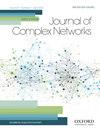Scaling laws for properties of random graphs that grow via successive combination
IF 1.5
4区 数学
Q2 MATHEMATICS, INTERDISCIPLINARY APPLICATIONS
引用次数: 0
Abstract
We consider undirected graphs that grow through the successive combination of component sub-graphs. For any well-behaved functions defined for such graphs, taking values in a Banach space, we show that there must exist a scaling law applicable when successive copies of the same component graph are combined. Crucially, we extend the approach introduced in previous work to the successive combination of component random sub-graphs. We illustrate this by generalizing the preferential attachment operation for the combination of stochastic block models. We discuss a further wide range of random graph combination operators to which this theory now applies, indicating the ubiquity of growth scaling laws (and asymptotic decay scaling laws) within applications, where the modules are quite distinct, yet may be considered as instances drawn from the same random graph. This is a type of statistically self-similar growth process, as opposed to a deterministic growth process incorporating exact copies of the same motif, and it represents a natural, partially random, growth processes for graphs observed in the analysis of social and technology contexts.通过连续组合增长的随机图性质的缩放定律
我们考虑通过分量子图的连续组合生长的无向图。对于任何为这样的图定义的性能良好的函数,在Banach空间中取值,我们证明了当同一分量图的连续副本组合时,必须存在一个适用的缩放律。至关重要的是,我们将之前工作中引入的方法扩展到分量随机子图的连续组合。我们通过推广随机块模型组合的优先附加操作来说明这一点。我们进一步讨论了该理论现在应用的广泛的随机图组合算子,表明在应用中增长标度律(和渐近衰减标度律)的普遍性,其中模块是相当不同的,但可以被认为是从同一随机图中绘制的实例。这是一种统计上的自相似增长过程,与包含相同主题的精确副本的确定性增长过程相反,它代表了在社会和技术背景分析中观察到的图形的自然,部分随机的增长过程。
本文章由计算机程序翻译,如有差异,请以英文原文为准。
求助全文
约1分钟内获得全文
求助全文
来源期刊

Journal of complex networks
MATHEMATICS, INTERDISCIPLINARY APPLICATIONS-
CiteScore
4.20
自引率
9.50%
发文量
40
期刊介绍:
Journal of Complex Networks publishes original articles and reviews with a significant contribution to the analysis and understanding of complex networks and its applications in diverse fields. Complex networks are loosely defined as networks with nontrivial topology and dynamics, which appear as the skeletons of complex systems in the real-world. The journal covers everything from the basic mathematical, physical and computational principles needed for studying complex networks to their applications leading to predictive models in molecular, biological, ecological, informational, engineering, social, technological and other systems. It includes, but is not limited to, the following topics: - Mathematical and numerical analysis of networks - Network theory and computer sciences - Structural analysis of networks - Dynamics on networks - Physical models on networks - Networks and epidemiology - Social, socio-economic and political networks - Ecological networks - Technological and infrastructural networks - Brain and tissue networks - Biological and molecular networks - Spatial networks - Techno-social networks i.e. online social networks, social networking sites, social media - Other applications of networks - Evolving networks - Multilayer networks - Game theory on networks - Biomedicine related networks - Animal social networks - Climate networks - Cognitive, language and informational network
 求助内容:
求助内容: 应助结果提醒方式:
应助结果提醒方式:


